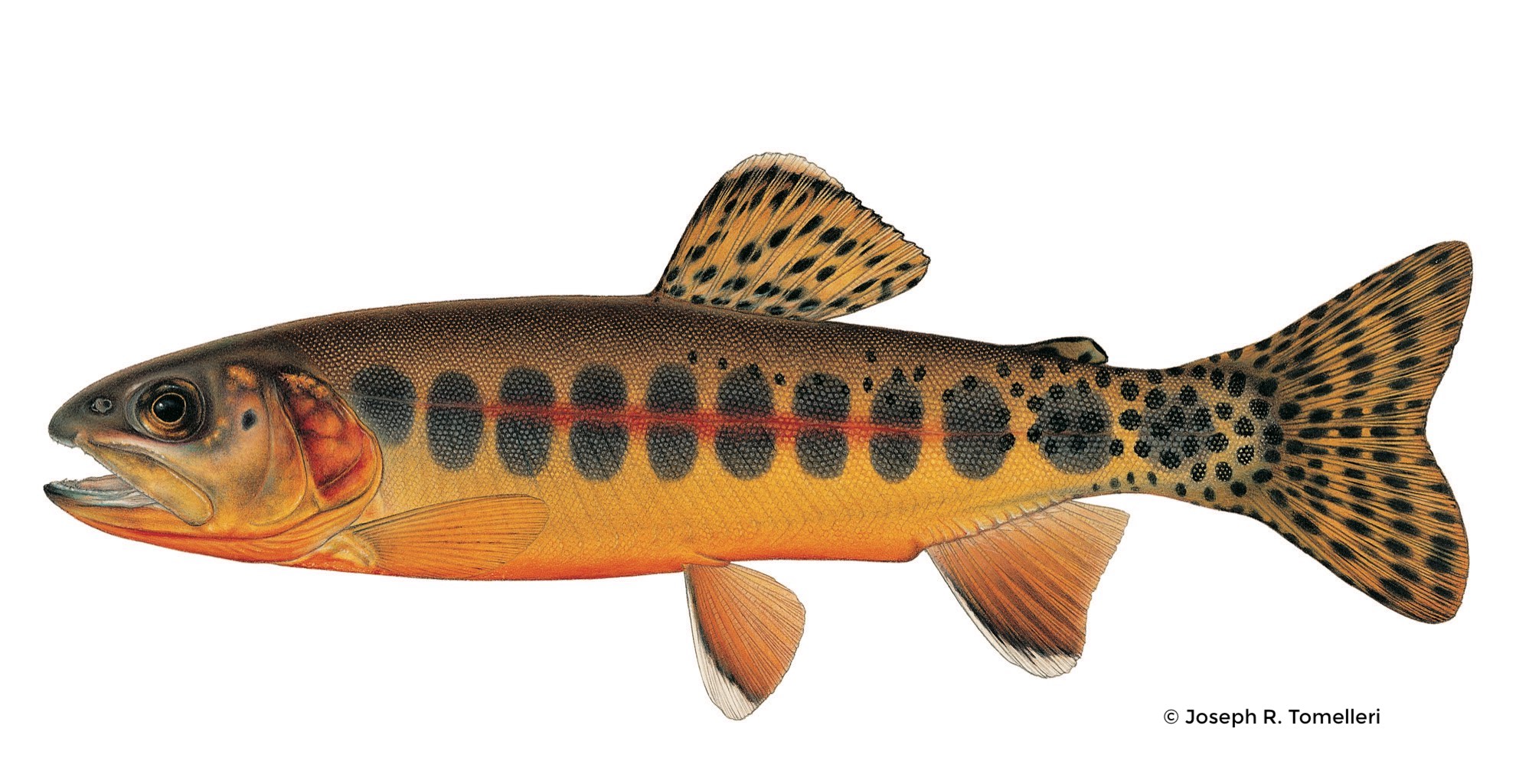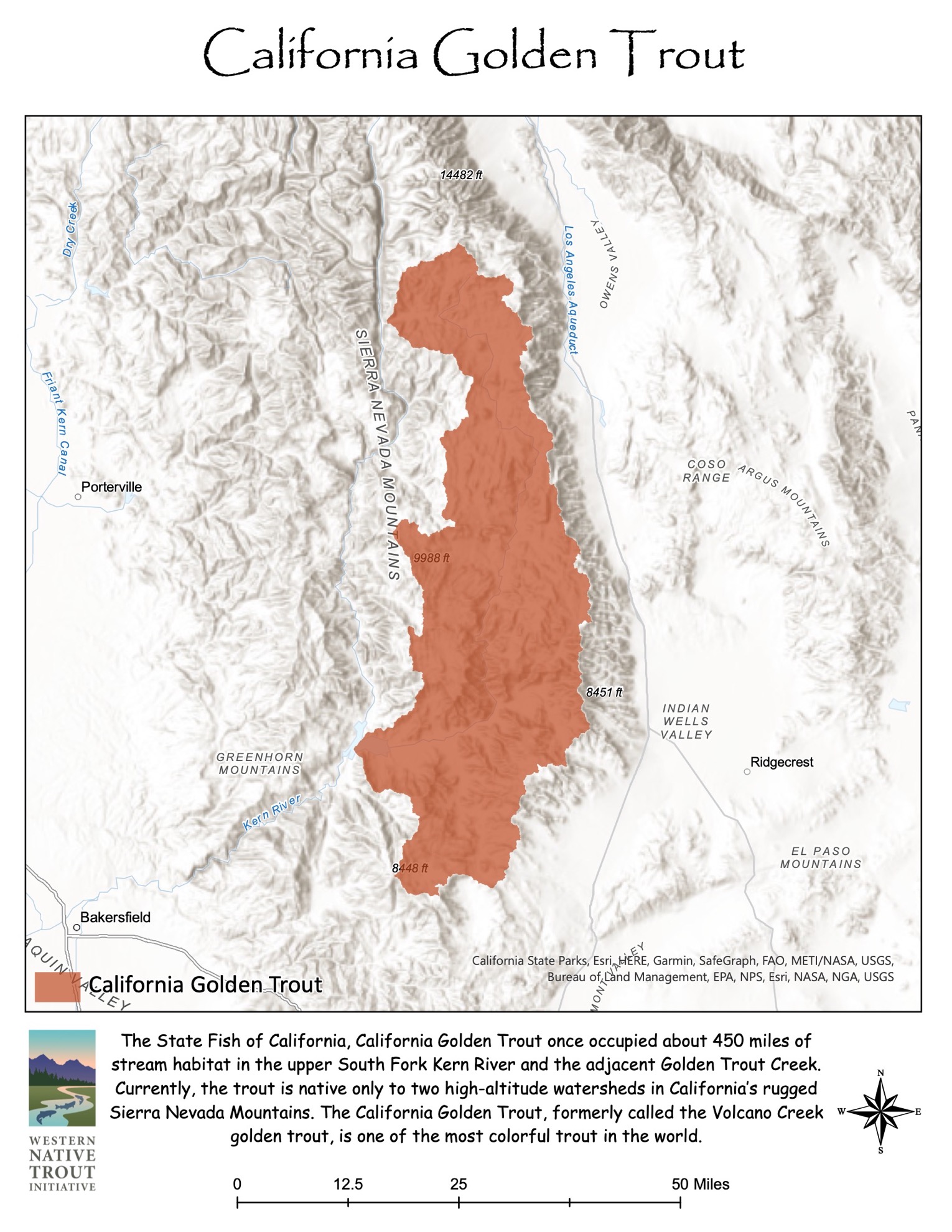
The State Fish of California, California Golden Trout once occupied about 593 miles of stream habitat in the upper South Fork Kern River and the adjacent Golden Trout Creek. Currently, the trout is native only to two high-altitude watersheds in California’s rugged Sierra Nevada Mountains. The California Golden Trout, formerly called the Volcano Creek golden trout, is one of the most colorful trout in the world.
The California Golden Trout (Oncorhynchus mykiss aguabonita; hereafter CAGT) is one of three subspecies of Rainbow Trout endemic to the Kern River Drainage (primarily Tulare County, CA), occupying this area alongside the Little Kern Golden Trout (O. mykiss whitei) and the Kern River Rainbow Trout (O. mykiss gilberti). California Golden Trout are brightly colored fish with a brassy or olive green colored dorsal side, intensifying to the characteristic golden/yellow moving down towards the ventral side of the fish. A crimson or red stripe runs laterally from the operculum (i.e., hardened plate covering the gills) towards the caudal peduncle (i.e., base of the tail) and ends approximately even with the anal fin. California Golden Trout have approximately 10 large spots, known as parr marks, present along the length of the lateral line.
California Golden Trout have been teetering on the brink of listing under the Federal Endangered Species Act (ESA) for decades. It was petitioned for Federal listing as Endangered by Trout Unlimited in 2000. In 2004 the US Fish and Wildlife Service (USFWS), the US Forest Service (USFS), and the CA Department of Fish and Wildlife (CDFW) signed a Conservation Agreement and Strategy to formalize their commitments to protecting these unique fish. The agreement was considered by the USFWS to be robust enough to preclude listing, and in 2011 the USFWS completed their 12-month review and ruled that listing was not warranted pursuant to the Endangered Species Act of 1973. However, CAGT are now designated as a Species at Risk by the USFWS. The USFS Region 5 has added CAGT to its Sensitive Species List and the CDFW has designated it as a Species of Special Concern.
The historic range of CAGT includes two watersheds draining the Kern Plateau of the southern Sierra Nevada Mountain Range in California. California Golden Trout are native to Golden Trout Creek (GTC) and the South Fork Kern River (SFKR), an area encompassing approximately 593 square miles. The GTC watershed covers 60 square miles. Elevations in this watershed range from 10,800 feet at Rocky Basin Lakes to less than 7,000 feet at the confluence of GTC and the Kern River.
California Golden Trout have been the target of intensive conservation and management actions by resource agencies in CA since the 1960s.
Recreational angling and harvest are permitted in both Golden Trout Creek and the South Fork Kern River. Angling pressure is relatively low, due to the remote location of these waters, and likely has minimal effects on the long-term viability of the species. CDFW monitors these populations annually for changes in fishing pressure, angling success, and angler satisfaction. The California Fish and Game Commission recognizes all waters in Golden Trout Creek as Heritage Trout Waters and all waters in the South Fork Kern River from the headwaters downstream to the South Sierra Wilderness border as Wild Trout waters. Both of these waters are open to public angling.
Since 2008, the Western Native Trout Initiative has contributed $48,000 to 2 projects benefiting California Golden Trout and Little Kern Golden Trout. Project goals were to estimate populations, analyze genetics, and trends in age, growth and size composition of the fishery as well as evaluate how changes in climate and the 2011 Lion Fire have affected trout populations.

Additional Resources
- READ MORE more about California Department of Fish and Wildlife’s efforts to conserve California Golden Trout.
- CLICK HERE to download a 2008 publication Restoration of the California Golden Trout in the South Fork Kern River, Kern Plateau, Tulare County, California 1966-2004 by E. P. (Phil) Pister.
Videos
On Sept. 19, 2016, California Department of Fish and Wildlife (CDFW) scientific staff rescued 52 California Golden Trout from Volcanic Creek and nearby wetland meadows in Tulare County. For the last three years, biologists have monitored the area and noticed a significant decrease in water due to the drought. CDFW believed the fish might not survive another dry winter, and a rescue effort was warranted. The fish in Volcanic Creek are a pure DNA strain of Golden Trout and are identified as a species of special concern, making the mission crucial. Federal laws forbid motorized vehicles on wilderness land, so the rescue had to be done the old-fashioned way, by horseback. It took staff four days at an altitude above 10,000 ft., hiking more than 32 miles round trip to conduct the rescue. The fish, averaging four inches in length, were captured and placed into fish transport cans containing cold oxygenated water and covered with wet burlap. They were loaded onto mules and carried out to the trailhead where they were transferred onto trucks and hauled more than 300 miles to the American River Fish Hatchery just east of Sacramento. The trout will be reared and returned to the wild next year if drought conditions improve. Watch a video about the rescue.
